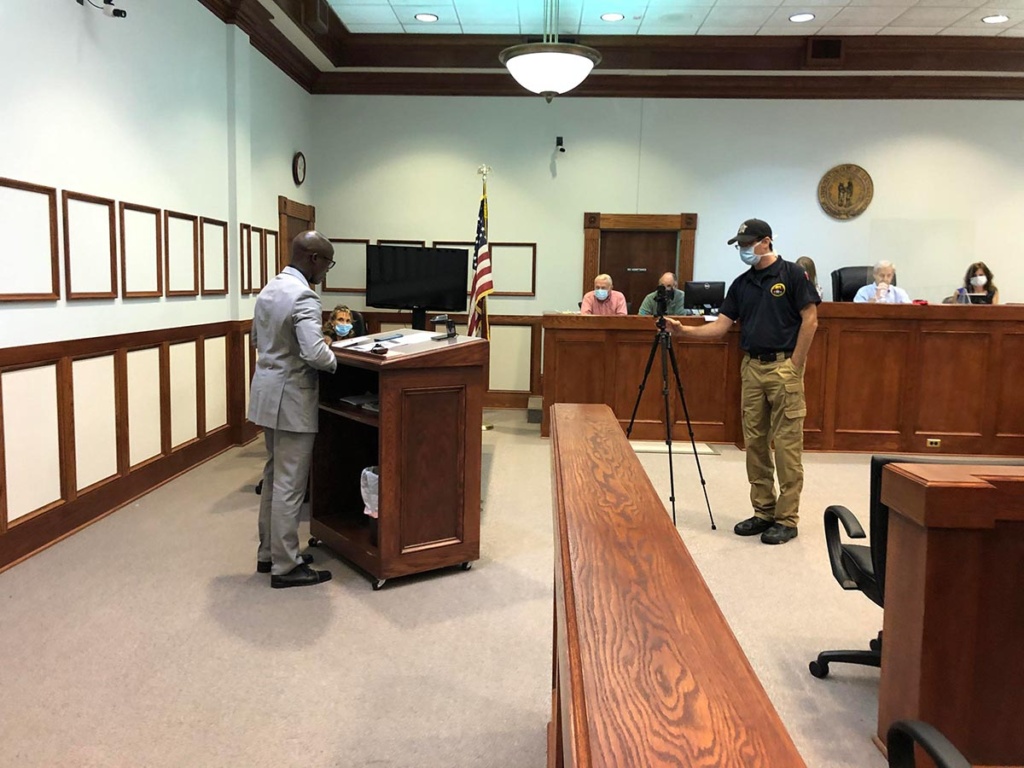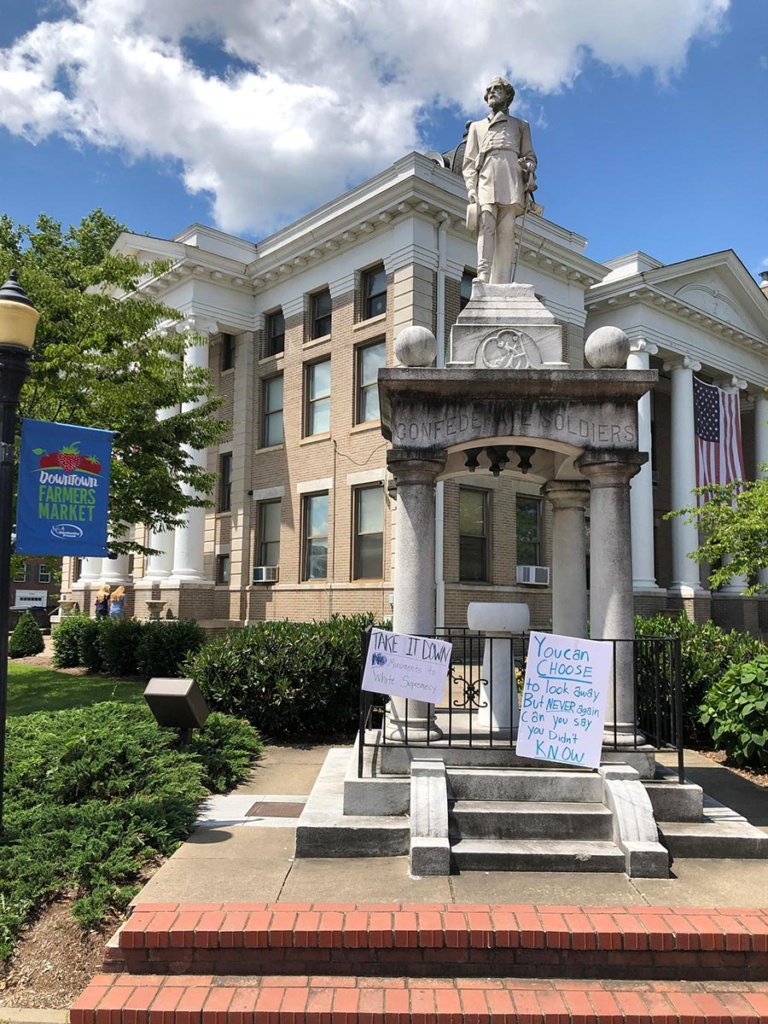The Calloway County Fiscal Court during its monthly meeting Wednesday declined to take any action on potentially removing a Confederate monument on county courthouse grounds.
Deputy Judge-Executive Gina Winchester in an interview following the meeting said the fiscal court held its meeting in the Calloway County Judicial Building due to the county courthouse annex’s small size and lack of air conditioning, making it unsuitable for a public meeting given coronavirus concerns.
Winchester said Circuit Court Judge Jamie Jameson approved the fiscal court’s request to have Wednesday’s meeting in the judicial building, but Jameson mandated the fiscal court follow COVID-19 restrictions ordered by the Kentucky Supreme Court. Those restrictions included having only 22 people total in the courtroom and asking attendees questions about COVID-19 symptoms before entering.

“Whatever we’re going to do in the short-term or the long-term will be done with every ‘i’ dotted and every ‘t’ crossed,” Imes said at the meeting. “There are a lot of other legal issues that I’ve been made aware of, specifically those. There are other permissions that we have to get prior to that.”
Imes did not immediately respond with comment on what specific legal issues or permissions could be barriers for potentially removing the monument, which features a statue of Confederate General Robert E. Lee. The monument was installed in 1917 with funds from the United Daughters of the Confederacy. Deputy Judge-Executive Gina Winchester said one of the issues is determining ownership of the monument.
In a separate interview Wednesday, County Attorney Bryan Ernstberger said he didn’t know what specific legal issues and permissions Imes was referring to, as Ernstberger hasn’t had the chance to fully study the issue. Ernstberger said Imes had previously asked him to look into the process for potentially removing the statue.
“This is not the only legal question that the court has posed to my office right now. In addition, we have a number of things that I’m doing work on,” Ernstberger said. “Frankly, some of those will have to be prioritized ahead. This is obviously a high-priority issue. This is not something that gets pushed to my backburner, but it’s not the most single pressing thing I have either.”
Ernstberger said he’s balancing looking into the legal question of removing the Confederate monument along with other priorities including determining how the county will implement a transient tax on hotels and businesses.
Speakers Comment On Monument
Two speakers, one advocating for the removal of the monument and the other opposing the removal, spoke to the fiscal court. Murray State Assistant Football Coach, U.S. Marine Corps veteran, and attorney Sherman Neal, who began calls for the monument’s removal in an open letter on June 1, told Imes and county magistrates the county could be a “beacon” for what’s right in Calloway County and beyond.
“We have the opportunity right now to be an exemplar for what happens and what can happen when you handle these type of divisive issues in a civil manner, specifically in towns like this,” Neal said to the court. “Rather being what’s wrong, in having that statue be the manifestation of what’s wrong and being the beacon to everybody in the nation that we don’t care about the thoughts and feelings of others.”

Neal said he was disappointed the fiscal court failed to at least approve a resolution stating the fiscal court’s intent to remove the monument, and believes the fiscal court’s inaction could embolden the opposition to the statue’s removal. He also said the inaction could hurt the region’s economy due to public backlash affecting business growth.
“From a transparency and accountability standpoint, it makes it difficult for any person on any side to know where we’re at right now with this process, or if anyone is even listening,” Neal said. “It’s the values that people assign to a piece of granite and marble over living, breathing people and citizens of this community.”
Neal said he plans to prepare for future hearings regarding the monument, and wants other people to be included in the discussion beyond himself. Neal originally asked for himself, University of Illinois student Linda Arakelyan who coordinated petitions calling for the removal, and Murray State Political Science Professor Kevin Elliott to present to the fiscal court.
County Attorney Bryan Ernstberger sent Neal an email in the late afternoon on Tuesday informing Neal only he would be able to attend this meeting due to coronavirus restrictions at the judicial building, and that an updated policy would be considered at the meeting to allow more speakers. Protesters both for and against the monument’s removal held signs outside the judicial building during the meeting.
Murray resident Blake Hughes, who works at Hughes Farm Service, was the other speaker who opposed the removal of the monument. Hughes said he wasn’t affiliated with any particular organization, including the Sons of the Confederacy.
“The removal of cultural monuments is cultural genocide,” Hughes said to the court. “No one who has spent all of their lives in our community should dictate the way we remember our ancestors’ history, or how we remember historical figures important to us.”

Hughes went on to say the push to remove the monument was about “marxist intent” on destroying history because “they hate us, our nation, and our god.”
Hughes also said he is worried about people tearing down the monument outside the due process of government. Imes did not immediately respond with comment on how Hughes was specifically chosen to speak to the fiscal court. Neal and Hughes after the meeting got into a debate about the monument, the conversation touching on police brutality and what kinds of monuments should or should not be removed.
Even though the fiscal court didn’t take any action on the monument, Deputy Judge-Executive Gina Winchester said the issue is still being pursued.
“This issue has not been dropped. We’ll continue to be at their forefront. Because of the COVID-19 restrictions imposed by the state, there’s no physical way a community town hall or round table discussion can happen right now because there’s no place big enough to get everybody in,” Winchester said in a statement. “Just like today’s meeting, we didn’t want to have to restrict anybody.”
Winchester said their office is still receiving public opinion on the statue removal, with support and opposition regarding the monument split in half.
“But most of those who’ve said move it, they don’t want it destroyed. We will continue to take any and all comments and concerns as long as we need to determine what is best for the citizens of this community,” Winchester said in a statement.
This meeting follows Murray State University, former Murray State basketball star Ja Morant, and Governor Andy Beshear all calling for the monument to be removed.
Transient Tax & Tourism Commission
In other business, the fiscal court also voted and approved two ordinances on 2nd reading: one to levy a “transient tax” on hotels and similar lodging to promote tourism in the county, and another to create a county tourism commission to oversee how the transient tax is used. The county tourism commission is separate from the Murray tourism commission.
This report first ran on WKMS.org.
Liam Niemeyer is a reporter for the Ohio Valley Resource covering agriculture and infrastructure in Ohio, Kentucky and West Virginia and also serves Assistant News Director at WKMS. He has reported for public radio stations across the country from Appalachia to Alaska, most recently as a reporter for WOUB Public Media in Athens, Ohio. He is a recent alumnus of Ohio University and enjoys playing tenor saxophone in various jazz groups.






